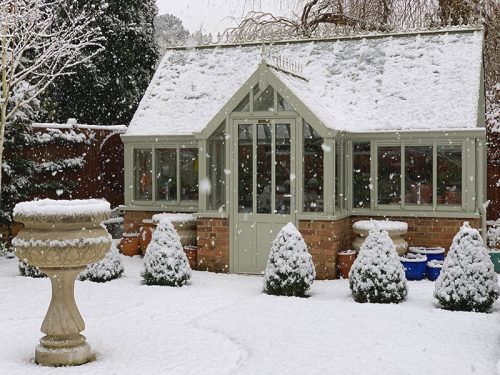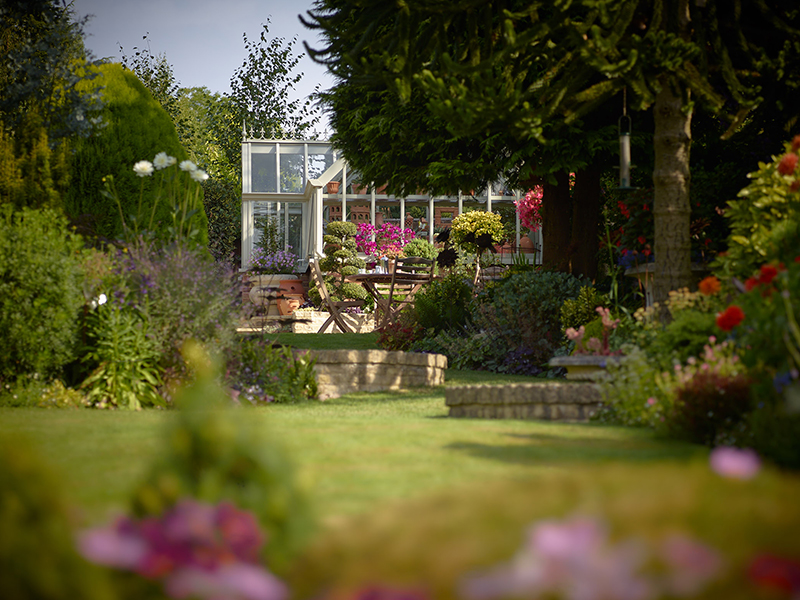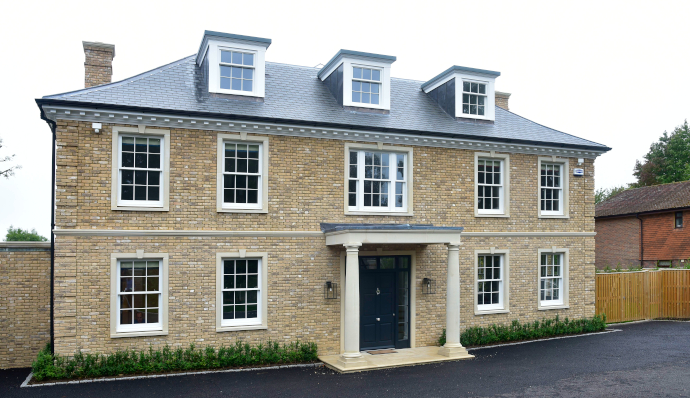Use The Winter Months To Plan Your Garden Design
Monday, February 08 , 2021

Winter is the best time to evaluate, plan and potentially change your garden design, and with all the herbaceous plants dormant you can get a better view to evaluate your space. Here’s some advice from our friends at Griffin Glasshouse on the benefits of reshaping the hard landscaping in your garden in winter. One of the main advantages of planning a garden redesign in winter, or making changes to the hard landscaping, is that the bare bones of your garden are exposed. This allows you to easily see the overall structure and what you might like to change or add to using plants or hard landscaping.
There are different aspects to consider especially if you plan to introduce a feature greenhouse as part of your overall garden design. Greenhouses are no longer just a functional item to be tucked away from view, there are many beautiful designs available that make them a worthy of a central garden focal point!
Get a good view of your garden layout
During winter many trees are without their leaves, so you get a better perspective on any sight lines both into and out of the garden. From there, you can evaluate what’s working for your garden and what isn’t. You can decide to open up a view to create the illusion of more space or block one to establish more privacy.
If you decide to move any trees or shrubs, then it’s best to carry out this work during the colder months. As they’ll be dormant, you’ll disturb the roots less than if you were to move them during the warmer, growing months, making your job easier and keeping your plants, trees and shrubs happier in the long run. Carrying out any work on your garden over winter will also cause less disturbance to any wildlife, which is always a plus.

Winter is a great time to clear out plant pots, see where to place your garden bench and sow seeds inside a glasshouse, especially if it’s heated.
Design to Protect Your Garden
The way you redesign your garden landscape can help you protect it from future winter damage too. There are a number of factors to take into consideration. Which direction do the harsher winter winds blow from? Having an effective wind break in place, like a hedge or fence will provide protection. Also think about any plants vulnerable to wind and frost damage and move them to a more shielded position. Key focal points like fountains are better placed away from strong winds that can blow the water out from shallow tiers in bad weather. Note the areas of your garden that receive the most or least sunlight, and at what time, and position your plants accordingly. You also need to consider this if you plan to install a greenhouse or a sundial. Lastly, if you’re in an area that’s likely to get snow you should ideally have space to shovel it and pile it up for clearing pathways.

Frozen fountains look dramatic, but make sure you care for them properly in freezing temperatures.
Gather garden inspiration
While there might be less to do out in the garden, cold winter days are the perfect time to curl up with a cup of tea and get some garden inspiration from books, magazines and online. Spending some time browsing and dreaming could be just the space you need to come up with garden design ideas that are perfect for your plot.
There’s a whole host of books and magazines (both physical and digital) out there that specialise in gardening, garden design and outdoor landscaping. There are plenty of sources of inspiration on social media too. Why not try searching garden design-related hashtags on Instagram? Pinterest and Houzz are also great places to find ideas. Social media is also a great way to catch up with all the latest garden trends and is usually filled with lots of helpful tips, tricks or advice for doing it yourself, too.
Another way to gather inspiration is by looking back at photos of your own garden. Looking through garden photos taken throughout the years and the seasons, no matter whether good or bad, is invaluable for deciding what works for the vision you have for your garden and what could be added, improved or removed. You may also find it useful to keep a garden journal to record successes and failures, when plants bloom and any maintenance that is carried out.

Greenhouses and hard landscaping, such as patios are investments to last for years.
Structural changes in your garden are best tackled in winter
If your garden design planning involves hard landscaping, the creation of new steps, paths, patios and flower beds, then the winter is the perfect time to do this. It’s also a great time to test the ground for statues and fountains. Avoid places where the ground slides in heavy rain as you need a solid base. When you are investing in your garden you want to make sure you have prepared properly to avoid making expensive mistakes!
If you are thinking of carving out space for a greenhouse as part of this change then there are many factors to consider that will affect its placement. So here are a few things to think about when planning the installation of a greenhouse or glasshouse. Firstly, the position in the garden is important depending on what you intend to grow. For example, alpines need a shady site, whereas summer crops prefer a lot more sunshine. Also, how much bench and floor space do you require inside the greenhouse? If you plan on growing frost tender or exotic plants all year round you will need heating and an electricity supply. How much garden space do you have for your greenhouse and what type of style compliments your tastes and property? Are you looking for a smaller, free-standing greenhouse, or would it work best installed against a wall? Your plants will need a water source, would you like a tap from the mains supply or would you like to collect rainwater from the greenhouse roof internally or externally? There are many options to consider. Also, is your greenhouse just for growing, or do you plan to add some furniture to create a gardening sanctuary, perfect for some quiet me time?

Glasshouses can be attached to your property as a garden living space.
Planning permission
Depending on its position and proximity to your house, you may also need planning permission for some glasshouse structures, so be mindful of this if you are planning to make large structural additions to your garden if you live in a National Park or a conservation area. These considerations should be made when finally embarking on an ambitious garden redesign you have been planning as proposals will need to be approved by the relevant authorities before construction can start. You will also need a qualified electrician to install the appropriate fittings for glasshouses or greenhouses with a mains supply and to power garden fountains and water feature pumps.
Luckily help is at hand. Griffin Glasshouses is a British family-owned business with more than 50 years’ experience delivering the highest quality glasshouses, backed by a lifetime structural guarantee. Whatever you have in mind and wherever you are in your planning process, including helping you get your glasshouse designs through the planning permission process, Griffin Glasshouses are happy to help. So please get in touch to discuss your greenhouse project.

Chilstone and Griffin Glasshouse have been exhibiting together for years. This was displayed at RHS Hampton Court.
Thank you to Griffin Glasshouses for this blog take over.
We have exhibited with Griffin for many years at RHS Chelsea Flower Show and RHS Hampton Court Show. Our Chilstone team are also here to advise you on other hard landscaping, architectural stone or garden ornaments for your homes, please get in touch 7 days a week.

Alan Titchmarsh with Steve Clark of Chilstone on the Griffin Glasshouse Stand at the RHS Chelsea Flower show in 2019.

Designed by Brand Skillings Ltd | Website managed by Weekend


